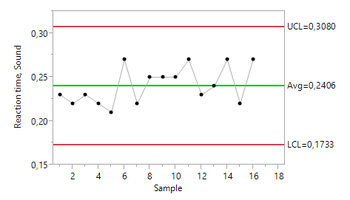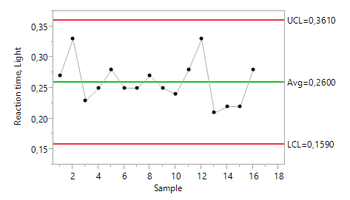
I was very impressed with Sissel's Lean Six Sigma knowledge. She makes it easy to identify improvements and create results.


The best way to find out is to test! You can do that at the Norwegian museum of Science and Technology.
I did an experimental design where I tested age, gender and sense (vision and hearing). My brother in law (35 years), my son (10 years), my niece (7 years) and I (41 years) were volunteers.
We measured the reaction time for sound and light.
My brother in law was a tiny bit faster than me when reacting to sound, followed closely by my son and my niece. For light my brother in law was fastest, then my son, followed by me and my niece. What does this result mean?
How much do age, sex and sense influence reaction time? What has the greatest impact?
By looking at the individual measurements it may look like men are faster than women to respond to light, and age 35-41 years is faster than 7-10 years. We reacted faster to sound than to light. For sound, it appears that the age 35-41 years is faster than 7-10 years. Are these conclusions correct?
It is easy to draw conclusions based on single measurements. Are the measurements representative? What is the natural variation?
I decided to use Statistical Process Control (SPC) and Control Chart, to decide the normal variation of reaction time. I repeated the measurements of my reaction time for sound and light several times. Here you can see the Control Chart with the normal variation of reaction time for sound and light:
So what does it mean? You can expect me to use between 0.17 and 0.31 seconds to react to sound. While my reaction time to light is between 0.16 and 0.36 seconds. Average reaction time is 0.02 seconds faster for sound than light.
What about the experiment where I tested different age and gender? All measurements were within the normal variation of light and sound.
What does it mean? This means that the differences observed are not significant (it's within the normal variation). In other words, the differences are not large enough to matter.
So what is my point? It can be easy to draw conclusions based on single measurements. If you do not compare the measurements with the normal variation of the process, it is easy to draw wrong conclusion.
All processes have variation! You can determine the normal variation by taking multiple samples of the process and use a Control Chart.
So what is fastest of vision and hearing? My ears reacted a bit faster than my eyes. However, when considering the normal variation this difference is not significant.
Lean Tech AS | Kristoffer Robins vei 13
0047 481 23 070
Oslo, Norway
L - Look for solutions
E – Enthusiastic
A – Analytical
N - Never give up

